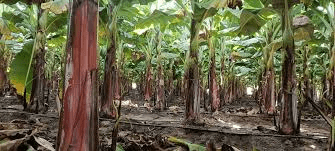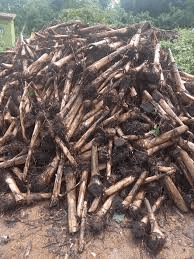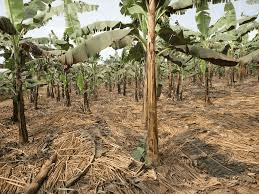Now that you have the land and have prepared it for planting your plantain suckers, does that guarantee your success on the field? The answer to that question is ”No” in capital letters! Not if you select the wrong cultivars, get unhealthy plantain materials from untrusted sources and poorly prepare them.
So now how then can you go about this?
By selcting cultivars:
Selecting Cultivars
Cultivars, short for “cultivated varieties”, are plants that are propagated without seed, but rather vegetatively (for example, via stem cuttings).
To select the most appropriate plantain cultivar, the following factors should be considered:
*The size of plant — the amount of leaves produced before flowering
*The type of bunch produced
*Customer preference should be considered.
Several types of conventional planting material exist which includes:
- Peeper: a small sucker emerging from the soil.
- Sword sucker: a large sucker with lanceolated leaves also known as the best conventional planting material.
- Maiden sucker: This is a large sucker with foliage leaves.
- Bits: These are pieces of a chopped corm.
A new and most promising planting material consists of in-vitro plants which are small maiden suckers produced from meristem culture.
Meanwhile, Planting material can be collected from:
(a) An existing field, preferably an old field which is becoming unproductive. Otherwise damage to the roots may be caused when the suckers are being dug out and many mother plants may later tip over.
(b) A multiplication plot: which is planted only for the production of suckers and not to produce bunches. Plant density (2 m x 2 m) is much higher than in production fields and suckers are obtained by either decapitation or false decapitation. Both methods consist of removing the growing point. In the first
method, the pseudo-stem is removed to get to the growing point. Only a small hole or window is cut for the second method. The foliage can remain active for up to 3 months after the removal of the meristem by the second method.
(c) A tissue culture laboratory, where in vitro plants which look like small maiden suckers are produced from meristems. In-vitro plants are healthy, vigorous, free from pests and diseases and have a great future.
Read Also: Methods of Propping and Harvesting of Plantains
Basically, there are three types of planting materials: the Sword Sucker, the Maiden Sucker, and the Bull Head . The Sword Sucker is the choice above all the other planting materials – the longer it is with a full corm at the base, the better it will grow under favourable conditions.
In Summary
Selecting Cultivars
Cultivars, short for “cultivated varieties”, are plants that are propagated without seed, but rather vegetatively (for example, via stem cuttings).
To select the most appropriate plantain cultivar, the following factors should be considered:
*The size of plant — the amount of leaves produced before flowering
*Yhe type of bunch produced
*Customer preference should be considered.
Conventional Planting Materials

Peeper: a small sucker emerging from the soil.
Bits: pieces of a chopped corm.
Maiden sucker: a large sucker with foliage leaves or a large pseudostem which does not produce fruit.
Sword suckers: have a narrow base, short pseudostem and narrow, blade-like or lanceolated leaves. They produce healthy, fruitful pseudostems when they mature. IT is the best conventional planting material
Water suckers: have short pseudostems and broad leaves.
Water suckers are not strongly attached to the rhizome and generally produce weaker plants and less fruit. Hence, maidenheads and large sword suckers are preferred over water suckers.
Sources of planting materials
*An existing plantain farm, most preferably an old field with healthy suckers.
*A multiplication plot whose sole aim is for sucker production and not for plantain.
*A tissue culture laboratory/micro-propagated plants — for producing healthy, improved, pest and disease free in-vitro plants.
The underlining statement is that planting materials should be obtained from healthy sources. In a situation where the true status of the suckers are unknown, planting materials should first be treated to remove or kill pests in the corm and roots.
Read Also: Methods of Controlling High Mat on Plantain
Getting the plantain suckers

Knowing fully well that a plantain plant is a type of herb not grown from seeds, they are propagated through suckers. Suckers are shoots that grow from a bud at the base of the plant) or from corms (underground bulbs known as rhizomes). They may be considered as baby plants that are used to start new plantain plants.
Choose suckers from plants that are vigorous. They should have small, spear shaped leaves and are about four feet high, especially the sword sucker.
There is a corm at the bottom of each mature plantain tree. In transplanting a sucker, it is necessary to cut downwards and get as much corm and root as possible. Plant these and cut or decapitate the sucker to facilitate good evaporation. Keep around two to five meters between planted suckers. In the early days of your plant, keep them moist but not too wet as they don’t have leaves yet to evaporate the water.
Preparing the suckers
Sucker preparation (peeling) is carried out in the field where the planting material is collected. This is to avoid contamination of the new field with roots infested with nematodes or corms with stem borers. Prepared corms are transported to their destination where they are left to dry for a few days (not in the sun).
Suckers are separated from their mother plant with a spade or machete. The sucker corm must not be damaged or chipped. Consequently the corm should be carefully peeled with a machete. The pseudo stem of the suckers should be cut off a few centimeters above the corm.
Peeling of the corm delays the development of nematode infestation, while cutting of the pseudo stem reduces bulkiness and improves early growth of the newly planted sucker. The peeling process is just like that for cassava. A freshly peeled healthy corm ought to look white, but corms infected by stem borers and nematodes show brown and black spots which have to be removed until only white tissue remains.
If the infestation is severe, with many brown and black spots, the sucker should be destroyed. Suckers have to be planted within two weeks. Storage of suckers for more than 2 weeks will adversely affect future yields.
Read Also: The Recommended Time and Method of Planting Plantain Suckers
Now that you know how to go about selecting the appropriate cultivar of plantain sucker, why not share it with your friends who might also need it?
Read Also: Why Every New Parent Needs a Baby Carrier
Frequently Asked Questions
We will update this section soon.

